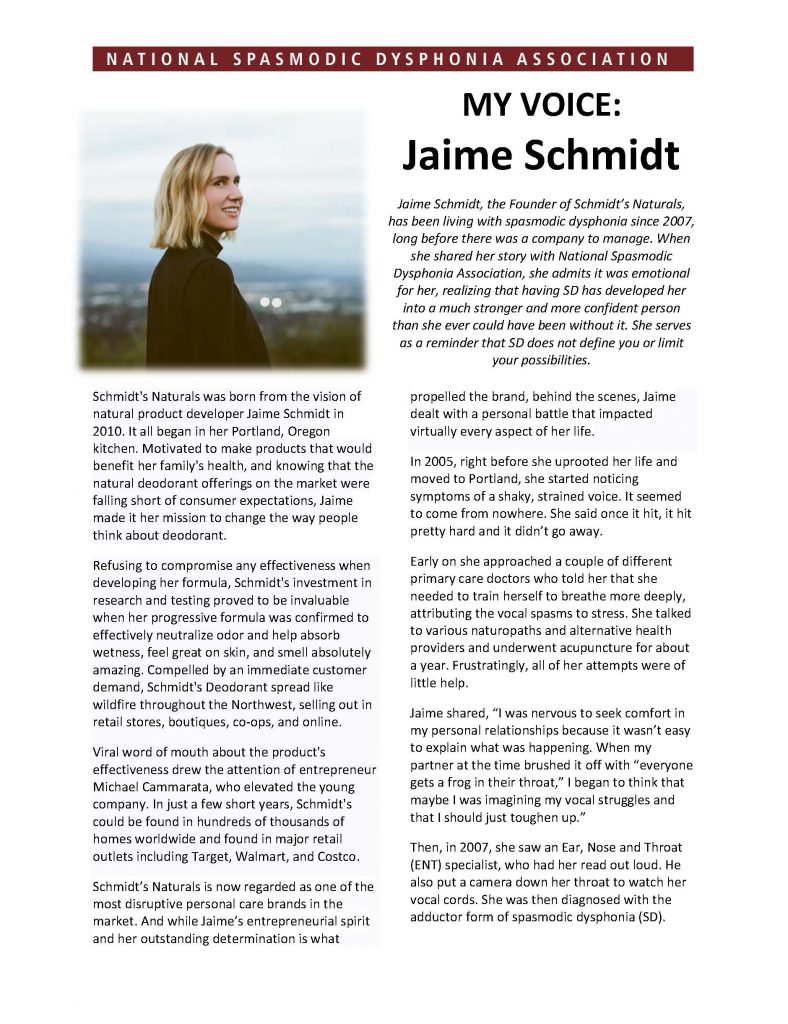Jaime Schmidt, the Founder of Schmidt’s Naturals, has been living with spasmodic dysphonia since 2007, long before there was a company to manage. When she shared her story with National Spasmodic Dysphonia Association, she admits it was emotional for her, realizing that having SD has developed her into a much stronger and more confident person than she ever could have been without it. She serves as a reminder that SD does not define you or limit your possibilities.
Schmidt’s Naturals started in her kitchen
Schmidt’s Naturals was born from the vision of natural product developer Jaime Schmidt in 2010. It all began in her Portland, Oregon kitchen. Motivated to make products that would benefit her family’s health, and knowing that the natural deodorant offerings on the market were falling short of consumer expectations, Jaime made it her mission to change the way people think about deodorant.

Refusing to compromise any effectiveness when developing her formula, Schmidt’s investment in research and testing proved to be invaluable when her progressive formula was confirmed to effectively neutralize odor and help absorb wetness, feel great on skin, and smell absolutely amazing. Compelled by an immediate customer demand, Schmidt’s Deodorant spread like wildfire throughout the Northwest, selling out in retail stores, boutiques, co-ops, and online. In just a few short years, Schmidt’s could be found in hundreds of thousands of homes worldwide and found in major retail outlets including Target, Walmart, and Costco.
Schmidt’s Naturals is now regarded as one of the most disruptive personal care brands in the market. And while Jaime’s entrepreneurial spirit and her outstanding determination is what propelled the brand, behind the scenes, Jaime dealt with a personal battle that impacted virtually every aspect of her life.
But she had a strained voice that wouldn’t go away
In 2005, right before she uprooted her life and moved to Portland, she started noticing symptoms of a shaky, strained voice. It seemed to come from nowhere. She said once it hit, it hit pretty hard and it didn’t go away.
Early on she approached a couple of different primary care doctors who told her that she needed to train herself to breathe more deeply, attributing the vocal spasms to stress. She talked to various naturopaths and alternative health providers and underwent acupuncture for about a year. Frustratingly, all of her attempts were of little help.
Jaime shared, “I was nervous to seek comfort in my personal relationships because it wasn’t easy to explain what was happening. When my partner at the time brushed it off with “everyone gets a frog in their throat,” I began to think that maybe I was imagining my vocal struggles and that I should just toughen up.”
She’s diagnosed with spasmodic dysphonia
Then, in 2007, she saw an Ear, Nose and Throat (ENT) specialist, who had her read out loud. He also put a camera down her throat to watch her vocal cords. She was then diagnosed with the adductor form of spasmodic dysphonia (SD).
Jaime walked away from the visit with the ENT, a little traumatized by the camera going down her throat, but feeling hopeful about the diagnosis, because identifying the condition meant the possibility for effective treatment. That night during a Google search she learned that SD was a very rare and incurable neurological condition. She knew her life might be forever changed.
About SD
Spasmodic dysphonia is a neurological disorder that affects the larynx. There are two primary forms, adductor and abductor. Jaime suffers from adductor spasmodic dysphonia (AdSD), which is the most common form of SD. Spasms force the vocal cords together which impacts voiced speech sounds. The voice breaks while speaking, and continuously interrupts the flow of speech, making talking a struggle and can make a person very hard to understand.
There is no cure for SD; however there are treatments that help reduce the severity of symptoms. Jaime initially tried one Botox® treatment to improve the symptoms of SD, but then decided not to do more, and so for seven years she lived with her SD. Schmidt’s Naturals started as a hobby in 2010. Jaime was pregnant at the time and making personal care products for herself and her family. She was most excited about her natural deodorant formulas, since she could never find any brands that she was happy with. She quickly realized the potential in the marketplace for her products and began selling at farmers markets and community events around Portland. It didn’t take long before the brand gained major momentum and began to land placement in stores.
She finally seeks treatment
Then in 2014, a few years after launching her business, she was approached about an interview feature on Fox News. Her first instinct was to decline the interview because of her SD, but she knew this was important for her business. It was an opportunity to spread the word about her young company. “So I flew cross country to NY, with a bag full of “treatments” in tow—throat lozenges, oils, magnesium for relaxation. I thought I could somehow pull this off and that I would magically sound perfect on TV (with SD and no experience with media). I was convinced I could outsmart this with my own personalized plan. But unfortunately, my voice sounded like its usual unstable self, and the added nerves of being on TV did not help. The episode aired a few months later, and when I saw it, I cried.” That’s when she knew she had to take this condition seriously and move forward with consistent treatment.
Jaime began Botox® treatment for her SD in November 2014. In SD, the muscles in the larynx spasm because too many or the wrong type of signals travel from the brain through the nerves to the larynx. Botox® blocks these nerve signals, reducing the number and severity of spasms. Dr. Joshua Schindler at Oregon Health and Sciences University (OHSU), administers her injections through her neck and into her vocal cords, allowing for a smoother voice. “Botox® treatments don’t work for everyone with SD, but for me, they work beautifully. If you didn’t know me and you met me during my “good voice” times, you’d certainly never know about my condition.”
Botox® only provides temporary relief for the symptoms. “Fortunately, my patterns have become almost predictable, and I’ve gotten good at scheduling my appointments at regular intervals (about every 10-12 weeks).” In addition, Jaime notes that Dr. Schindler has perfected the art of needle placement to ensure a successful dose for her.
Jaime has grown to own her SD
Before Schmidt’s Naturals, Jaime spent a long time trying to find her career path and always felt unfulfilled. She now wonders if her disorder was a part of it. “I felt like I could never reach my potential. It was hard for me to communicate with confidence.”
As most with SD know, talking on the phone with an untreated SD voice is a challenge, so she avoided it at all costs and her first employee hired answered all the calls. But now, “I’ve grown to own this disease”, says Jaime. “I keep things in perspective and avoid feeling sorry for myself, but of course it’s been an emotional roller-coaster. I like to think that I now have a healthy relationship with it.”
Jaime admits it took her a while to feel comfortable talking about her voice condition. Prior to treatment, she would often tell people that she was getting over a cold or other sickness. Jaime never intended to deceive people–it just wasn’t something that could be explained quickly – recognizing that it’s a pretty personal story to share lightly.
“Once I began receiving regular Botox®, my voice went through the cycles: whispery, soft, and back to strained. This is when I began to feel more comfortable saying that I had a vocal condition and to excuse my voice (or please listen harder!). When my voice is good, I genuinely feel like I can take on the world. In this sense, SD has developed me into a much stronger and more confident person than I ever could have been without it.”
Balancing her career with her SD treatments
Living with the condition and balancing her position at the company have been challenging. “I’ve had to be very strategic in planning some of my work-related travel and activities. I take part in a lot of press and trade events, and when an opportunity comes up, my first thought is, what voice phase will I be in at that time?” It’s difficult to manage a calendar far in advance, because she needs to consider timing of Botox® treatments and she has to account for the breathy/quiet voice phase that follows every injection.
In addition, she has had to be a leader with a voice disorder and has a style that reflects this “It’s not always easy to command a room without a strong and consistent voice.” Jaime doesn’t know if it is because of SD or if she was always this way, but she finds that her non-threatening ways and humbleness has been a great asset when working with the people at Schmidt’s Naturals. She believes it creates an environment of respect.
“SD has certainly posed challenges, but I’ve never allowed it to prevent me from taking on new opportunities in my work. When I’m in my normal voice phase with Botox® treatments, I welcome any phone call and love to hear myself speak. And with my treatments, those TV features are now a breeze. In fact, the professional experiences I find most gratifying are those where I can educate and inspire others through sharing my story of founding and growing the business.”
Advice from Jaime, “embrace this disorder”
And grow the business Jaime has. Fast forward seven years, and the Schmidt’s Naturals brand is now a household name that can be found in over 30,000 retailers across the globe and has expanded into new product lines. This year the company was acquired by Unilever, one of the world’s largest consumer packaged goods companies. “Today, I am proud to say that I personally developed a disruptive brand bringing positive change to the personal care industry,” Jaime says.
For others struggling with SD she says, “Embrace this disorder the best you can.” She admits, “Some days are harder than others, and it’s ok to want to isolate yourself a little at times. But do talk about it with friends and family– it can bring such relief.” She also says, “SD is interesting and so rare; people will be intrigued in a genuine way.”



